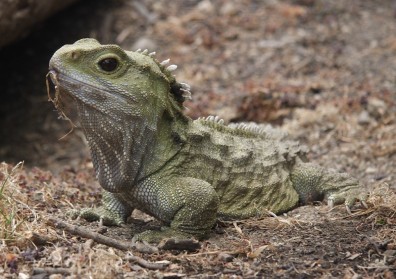For this post I thought would write about something on a brighter note, as my last posts have tended to be leaning more on the sinister side.
Tuatara are one of many iconic New Zealand animals. These reptiles are often described as living dinosaurs, as their species are over 200 million years old, existing during the time of the dinosaurs. They are the only remaining species in the order Sphenodontia. All other species in this order had become extinct around 60 million years ago. This in particular makes tuatara a great interest point to scientists studying the evolution of snakes and lizards (or squamates). It is with the squamates that tuatara share their closest common ancestor.

Tuatara (Photo: wikimedia commons)
The tuatara survived in New Zealand (after the invasion of pests) only on 32 offshore islands, all of which had remained predator free. Their biggest threat are rodents, as they prey on tuatara eggs and young, as well as compete directly with their food sources. Compared to other reptiles tuatara have a wide variety of prey, including weta, beetles, spiders and even small lizards. The tuatara have a unique set of teeth, which allows for them to eat such variety. They have two rows of teeth in the upper jaw, and one on the bottom. It is not advisable to get bitten by one, once they clamp down it’s near impossible to prise them off until they decide to let go!
Another trait that makes tuatara so unique is that they can function normally in temperatures as low as 7°C, (even though they are cold-blooded). This is the lowest of all reptiles. Their optimal temperature range, 16-21°C, is also the lowest of all reptiles.
There are large efforts taking place in order to save this endangered species. With these reptiles, breeding programs must be very patient as females only lay eggs on average once every four years, and then they must be incubated for around 11-16 months. Naturally this occurs in the ground, where the female buries them, but for the most successful rate of hatching, conservationists remove the eggs and transfer them to special incubators in order to keep a closer eye on them. Like other reptiles the temperatures the eggs experience during incubation determine the genders of the hatchlings. Tuataras don’t reach sexual maturity until their teens, and can live till at least 91 years, but are thought to be able to live till over 100 years. Adequate research concerning the tuatara lifespan is hard to carry out considering they generally live longer than we do!
There are a number of wildlife parks and sanctuaries around New Zealand that hold and work on breeding tuatara. A few include the Auckland Zoo, Rainbow Springs, and Zealandia Wildlife Sanctuary.
